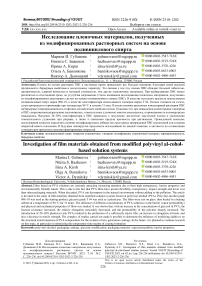Исследование пленочных материалов, полученных из модифицированных растворных систем на основе поливинилового спирта
Автор: Губанова М.И., Баженов Н.С., Кирш И.А., Банникова О.А., Дымицкий В.А.
Журнал: Вестник Воронежского государственного университета инженерных технологий @vestnik-vsuet
Рубрика: Химическая технология
Статья в выпуске: 2 (96) т.85, 2023 года.
Бесплатный доступ
Пленки на основе растворов ПВС в настоящее время привлекают все большее внимание благодаря своей высокой прозрачности, барьерным свойствам и экологичному характеру. Это связано с тем что, пленки ПВС обладает большей гибкостью, прозрачностью, ударной вязкостью и меньшей стоимостью, чем другие упаковочные материалы. При выбрасывании ПВС может разлагаться в естественной среде, не усугубляя загрязнения. Статья посвящена исследованию пленочных материалов, полученных из модифицированных растворных систем на основе поливинилового спирта (ПВС). В качестве исходного продукта использовался поливиниловый спирт марки 098-10, в качестве пластификатора использовался глицерин марки Т 94. Пленки отливали на стекле, затем прогревали в термошкафу при температуре 90 °С в течение 31 часа. Изучено влияние различных концентраций растворов ПВС на барьерные (паропроницаемость) и физико-механические свойства пленок. Показано что, при повышении концентрации глицерина в ПВС сопротивление разрушению увеличивалось, относительное удлинение заметно уменьшалось, а проницаемость полимера резко повышалась. Введение 20-30% пластификатора в ПВС приводило к получению достаточно эластичной пленки к увеличению относительного удлинения при разрыве, а также к снижению предела прочности при растяжении. Проведенный комплекс исследований позволил определить влияние модифицирующих добавок на структурные превращения ПВС композиций для создания покрытий нового поколения. В будущем планируется продолжить исследования по данной тематике, в частности по оптимизации температурно-временного режима формирования покрытий.
Поливиниловый спирт, покрытия упаковочные, глицерин, модификация, упаковочный материал, паропроницаемость, барьерные свойства
Короткий адрес: https://sciup.org/140303211
IDR: 140303211 | УДК: 640 | DOI: 10.20914/2310-1202-2023-2-226-236
Текст научной статьи Исследование пленочных материалов, полученных из модифицированных растворных систем на основе поливинилового спирта
Пленки на основе растворов ПВС в настоящее время привлекают все большее внимание благодаря своей высокой прозрачности, барьерным свойствам и экологичному характеру. Это связано с тем что, пленки ПВС обладает большей гибкостью, прозрачностью, ударной вязкостью и меньшей стоимостью, чем другие упаковочные материалы. При выбрасывании ПВС может разлагаться в естественной среде, не усугубляя загрязнения.
Хотя пленки, изготовленные из одного материала, имеют простой технологический процесс, физические характеристики и термическая стабильность таких пленок всегда недостаточно высокие [15]. Следовательно, для улучшения характеристик пленок из одного материала необходимо сочетать с другими веществами и способами обработки для достижения цели практического применения [12].
Установлен экстремальный характер зависимости физико-механических характеристик полимера от содержания пластификатора в широком диапазоне концентраций пленок покрытия на основе ПВС. Показано, что влияние многокомпонентных систем с протеканием побочных реакций между пластификатором и структурирующим агентом пластификатора на свойства структурированного ПВС выражено менее резко по сравнению с чистым полимером. Установлено, что введение этилового спирта в водный раствор ПВС интенсифицирует процесс формирования пленки. Показано влияние состава растворителя на физико-механические свойства пленочного материала на основе ПВС. Показано влияние порядка введения этилового спирта при приготовлении раствора на структуру и свойства пленочного материала.
Пленки, изготовленные из одного материала, имеют простой технологический процесс, физические характеристики и термическая стабильность таких пленок всегда разочаровывают. Следовательно, пленки из одного материала необходимо сочетать с другими веществами и способами обработки для достижения цели практического применения.
Некоторые предыдущие исследования проводились с композитными пленками. Однако, насколько нам известно, ранее сообщалось о нескольких исследованиях съедобных композитных пленок на основе различных компонентов. Поэтому в данной работе исследовали структуру, механические, барьерные и оптические свойства четырех пищевых пленок на основе ПВС, с различной концентрацией и обработанные и не обработанные ультразвуком.
Существует много природных биоразлагаемых полимеров таких как, хитозан и производные целлюлозы которые используются для, упаковки пищевых продуктов для сохранения безопасности пищевых продуктов, а также, жизнеспособности окружающей среды. Однако низкая водостойкость и чувствительность к изменению рН приводят к росту интереса к использованию синтетических биоразлагаемых полимеров Поливиниловый спирт ПВА обладает характерной химической стойкостью в сочетании с гидрофильными свойствами, что сделало его перспективным кандидатом в пищевую упаковку.
Растет интерес к разработке биополимеров и инновационных технологических процессов, которые могут снизить зависимость от ископаемого топлива и перейти на экологически чистую материальную основу. В исследовании группы ученых говорится, что на сегодняшний день наиболее изученными бионанокомпозитами, подходящими для упаковки, являются производные крахмала и целлюлозы, полимолочная кислота (PLA), поликапролактон (PCL), полибутиленсукцинат (PBS), поливиниловый спирт (PVA) и полигидроксибутират (PHB) [24].
Также в другом исследовании рассказывают, что в последние годы большое внимание было сосредоточено на исследованиях по замене сырьевых пластмасс на основе нефти экономически эффективным способом биоразлагаемыми материалами, обладающими конкурентоспособными механическими свойствами [33]. Биополимеры считались наиболее перспективными материалами для этой цели.
Биоразлагаемые полимеры можно разделить на четыре категории в зависимости от синтеза и источников [7, 11, 31]:
-
1. Полимеры из биомассы, такие как агрополимеры из агроресурсов;
-
а. полисахариды, например, крахмалы (пшеница, картофель, кукуруза) [8, 13, 22], лигноцеллюлозные продукты (древесина, солома, и др.) [26] (пектины, хитозан / хитин, камеди) [30], б. белки и липиды, например, животные (казеин, сыворотка, коллаген / желатин) [6, 8, 16, 19, 28, 36] и растительные (зеин, соя и глютен) [10], 2. полимеры, полученные микробиологическим путем, например, полигидроксиалканоаты (PHA), такие как поли(гидроксибутират) (PHB) и поли (гидроксибутират когидроксивалерат (РНВv);
-
3. полимеры, химически синтезированные с использованием мономеров, полученных из агроресурсов, например, полимолочная кислота (PLA);
-
4. полимеры, мономеры и полимеры которых получены химическим синтезом из ископаемых ресурсов, например, поликапролактоны (PCL), полиэфирамиды (PEA), алифатические сополиэфиры (например, PBSA) и ароматические сополиэфиры (например, PBAT).
Только последняя категория получена из невозобновляемых ресурсы. Первая категория рассматривается как агрополимеры, а другие называются биоразлагаемыми биополиэфирами [10]. Синтетические полимеры постепенно заменяются биоразлагаемыми материалами, особенно получаемыми из природных ресурсов, из-за их способности к биологическому разложению.
Так, например, группой ученых [5] были изучены и получены многослойные материалы с хорошей межслойной адгезией. Была применена термокомпрессия для ламинирования внутреннего слоя поливинилового спирта (PVA) с двумя внешними слоями полимолочной кислоты (PLA). Многослойные пленки были охарактеризованы с точки зрения их микроструктуры, тепловых характеристик, растягивающих и барьерных свойств.
Также была изучена антимикробная способность материалов путем анализа упакованных образцов говяжьего мяса в течение 17 дней при температуре 5 °C. Активные многослойные слои эффективно контролировали рост микробов в говяжьем мясе во время холодного хранения.
Разработанные группой учёных ламинаты демонстрировали растяжимость свойства, близкие к свойствам пленок PLA, но с повышенной растяжимостью. По сравнению с монослоями барьерная способность многослойных слоев была значительно улучшена за счет сочетания слоев полиэстера и ПВА, которые обеспечивают слоистому слою способность пропускать водяной пар и кислород соответственно. Таким образом, материалы были функционально адекватны для упаковки пищевых продуктов и успешно способствовали сохранению мяса.
В данном исследовании [14] новая полувзаимопроникающая гидрогелевая сеть, состоящая из диакрилата полиэтиленгликоля (PEGDA) / поливинилового спирта. (ПВА) / трагакантовая камедь (ТГ) с адаптируемыми механическими, биологическими и физическими характеристиками была изготовлена для целей заживления ран. В нем оценивали степень набухания, механические характеристики, скорость пропускания водяного пара (WVTR), фракцию геля и способность к разложению гидрогелей.
Результаты их работы показали, что включение ПВС в сетки увеличивает коэффициент набухания и снижает пористость. Кроме того, по мере увеличения отношения PEGDA к PVA, отношение WVTR, клеточная адгезия и удлинение сетей увеличивались. Также было обнаружено, что при уменьшении количества PEGDA скорость деградации сетей снижается. Результаты подтвердили нетоксичность гидрогелевых сетей PEGDA/PVA/TG. Таким образом, использование опыта полученного при разработке данного перевязочного материала можно использовать в разработке пищевой пленки.
В рассматриваемой работе [15] был применен катехин как антиоксидантное средство. Его стабильности была повышена за счет конъюгации катехина с крахмальным альдегидом. Полученные конъюгаты крахмал-альдегид-катехин добавляли в смесь четвертичного аммония хитозан (ЧАС) / поливиниловый спирт (ПВС) для приготовления активных упаковочных пленок. В результате ими были получены показали, что конъюгаты крахмал-альдегид-катехин образуют водородные связи с пленкой ЧАС/ ПВС.матриц и изменил однородность пленок. Паропроница-емость, прочность на разрыв и относительное удлинение при разрыве пленок увеличились на 2,51%-16,03%, 11,73%-20,15% и 0,78%-12,15% соответственно; тогда как кислородопроницае-мость пленок снизилась на 6,67%-53,33%. Также результаты апробации пленок на арахисовом масле показали, что пленки ЧАС/ПВС, содержащие конъюгаты крахмал-альдегид-катехин, низкие значения пероксидного числа и уровни реакционноспособного вещества тио-барбитуровой кислоты.
В исследовании [17] были извлечены экстракты из 14 растений. Полученные экстракты, богатые антоцианами, иммобилизовали в крахмале/ поливиниловом спирте. В последующем они были применены для разработки интеллектуальных упаковочных этикеток для контроля свежести свинины и креветок. Экстракты делали метки фиолетовыми, голубовато-фиолетовыми или коричневыми при изменении рН среды. Также экстракты также усиливали способность этикеток блокировать УФ-видимый свет, антиоксиданты. При применении экстрактов ими было выявленно несколько пленок с лидирующими показателями. Применение экстрактов в соединении не изучалось. Для бедующих исследований стоит отметить возможность смешивания экстрактов с высокими показателями в той или иной области.
Также другой группой ученых [27] была изучена и разработана биоразлагаемая пленка на основе цедры сладкого лайма, в которой порошок цедры сладкого лайма (SLPP) выступал в качестве наполнителя, а поливиниловый спирт (PVOH) и крахмал служили матрицей для проявления пленки. Промышленность по переработке сока сладкого лайма производит огромное количество кожуры сладкого лайма, которая считается отходом, и ее управление является ключевой проблемой для пищевого бизнеса. Из отходов, что также поможет решить экологические проблемы.
Для исследования свойств был использован метод литья из раствора и разработаны девять различных композитных пленок путем изменения пропорций порошка. Были получены результаты отмечающие значительные изенения в положительную сторону по таким показателям как: содержание влаги, растворимость, паропроницаемость, прозрачность, предел прочности при растяжении и относительное удлинение при разрыве.
В рассматриваемом исследовании [21] были изучены антибактериальные свойства и применение в пищевой консервации нановолокни-стых пленок (НФ) байкалинлипосомы (БКЛ-ЛП) Пленки загружали в поливиниловый спиртхитозановые (ПВС-ХС) субстраты для формирования НФ по технологии электроформования.
По результатам исследования выяснилось, что гладкие и однородные NF были сформированы посредством молекулярного взаимодействия между BCL-LP и матрицей PVA-CS. НФ проявляли хорошие антибактериальные эффекты в отношении Escherichia coli и Staphylococcus aureus за счет разрушения бактерий в результате доставки БКЛ в бактериальные клетки с помощью липосом. Кроме того, NF были совместимы с фибробластами L929. NF BCL-LP/PVA-CS ингибировали потерю веса, потемнение, прогорклость и рост бактерий, а также поддерживали питательные вещества грибов. Использование данного опыта должно хорошо сказаться в дальнейших исследованиях.
В следующей работе [25] рассматриваются нанокомпозиты полимер-серебра, считающиеся перспективными функциональными материалами благодаря их уникальным оптическим, антибактериальным и электрическим характеристикам. Поливиниловый спирт (ПВС) и серебряные нанокомпозитные пленки изготавливаются методом литья из раствора с последующими различными периодами термообработки для исследования соответствующей структуры, а также их оптических, электрических и механических характеристик.
Было изучено влияние нагрева на образование однородных сферических наночастиц серебра размером 18,5–40,7 нм при различных периодах нагревания и, соответственно, интенсивность пика поверхностного плазмонного резонанса наночастиц серебра увеличивается, что указывает на генерацию большего количества наночастиц с периодом нагревания. Это позволяет утверждать, что и антибактериальные свойства полимера изменяются за счет этого.
Данной группой ученых [29] был приготовлен гибридный раствор с использованием различного процентного содержания сшивающего агента в поливиниловом спирте и тетраэтилортосиликат для улучшения барьерных свойств двухосноориентированных полипропиленовых (БОПП) пленок. После нанесения покрытия были проверены печатные свойства, и было
В исследование [34] целью было приготовление активной и чувствительной к рН пленки на основе натрий карбоксиметилцеллюлозы / поливинилового спирта (CPVA) методом литья, который содержал экстракты антоцианов розы (RAE) для контроля свежести свинины. В результате ими было выявлено, что пленка 160-RАЕs-CPVA сильно реагировала на рН, показывая разный цвет при разных значениях рН. Кроме того, при мониторинге свежести свинины, хранившейся при 25 °C, светло-зеленый цвет пленки 160-RАЕs-CPVA указывал на более высокую свежесть свинины, а темно-зеленый и оранжевый цвет указывал на то, что свинина была испорчена. Таким образом, использование интеллектуальной пленки позволяет наглядно контролировать качество мяса при отсутствии возможности проследить за качеством условий хранения и транспортировки.
Так, например, при рассмотрении растворов в двух соотношениях ПВС / Хитозан (1:1 и 3:1) и нано-диоксид кремния (нано-SiО2) (0, 0,5 и 1%) в работе [18] были получены результаты изменения их растворимости в воде и снижения паропроницаемости (ПВС) пленок, а также при более высоком содержании ПВС, проверка на прочность показала наиболее высокие результаты. В конечном итоге существенного улучшения структурных и физико-химических свойств пленок удалось добиться при более высоком содержании ПВС и концентрации 1% нано-SiО2. Основываясь на их результатах, эти нанокомпозитные пленки можно считать подходящими для упаковочного сектора и сохраняющими качество пищевых продуктов.
Функциональные характеристики активных ингредиентов в биоразлагаемой упаковке можно повысить, контролируя профили их высвобождения [25]. Это может быть достигнуто путем включения активных ингредиентов в упаковку с многослойной структурой, включая многослойную и композитную упаковку. В многослойных материалах профилем высвобождения можно управлять, изменяя тип, структуру и толщину различных слоев. В композитных материалах профилем высвобождения можно управлять, изменяя взаимодействие активных ингредиентов с окружающей биополимерной матрицей.
Таким образом, использование добавок в растворах на основе ПВС позволяет добиться более лучших показателей в различных физико-механических, барьерных и других свойствах при сохранении прежних свойств присущих данной основе.
Для повышения физико-механических и придания повышенных барьерных свойств этих пленок, исследуется добавление пластификаторов для повышения безопасности и качества пищевых продуктов. После проведенного анализа литературы, водорастворимым пластификаторам, которые могут быть включены в пленки, уделяется большое внимание, поскольку они следуют за основным свойством ПВС и придают ему новые.
В ходе работы нами была поставлена цель разработать модифицированную полимерную композицию, на основе ПВС, для формирования защитных покрытий, способствующую пролонгации сроков хранения пищевых продуктов.
Благодаря близости химического строения пластификатора и поливиниловый спирт являются совместимыми соединениями, что позволяет вводить в полимер значительные количества пластификатора до 75%.
Отмечается, что в присутствии воды пластифицирующая эффективность пластификатора увеличивается, подобно воде действуют также многие кислоты, что для нас имеет существенное значение, так как в качестве структурированного агента вводили в композицию щавелевую кислоту.
Считается, что эластичные пленки на основе поливинилового спирта получаются при введении в полимер 65% пластификатора. Для полимеров, контактирующих с пищевыми продуктами, введение таких больших количеств пластификатора нежелательно, т. к. значительном содержание в пленке пластификатора может мигрировать пищевые продукты и придать им посторонний привкусу что, несмотря на не токсичность и полную физиологическую безвредность пластификатора, не допускается.
В работе изучали влияние глицерина в широком диапазоне концентраций от 0 до 40% на свойства поливинилового спирта с целью выбора концентрации пластификатора для обеспечения требуемых характеристик пленочного материала.
Материалы и методы
В качестве исходного продукта использовался поливиниловый спирт марки 098–10 производство Китай регистрационный номер CAS: 9002–89–5, спецификация таблица 1. В качестве пластификатора использовался глицерин марки Т-94, спецификация таблица 2. Изменения средней толщины пленок в зависимости от концентрации таблица 3.
Таблица 1.
Спецификация ПВС
Table 1.
PVA specification
|
Плотность | Density |
1,19–1,31 г./см³ |
|
T Плавления | Melting |
> 300° С |
|
Рн |
5–7 |
|
Марка | Brand |
098–15(G) |
|
Основное вещество | Basic Substance |
95,3% |
|
Гидролизное число | Hydrolysis Number |
98,6% |
|
Температура разложения Decomposition temperature |
160–200℃ |
|
Таблица 2. Спецификация глицерина Table 2. Glycerin specification |
|
|
Цветное число, мг J2/100 см3, не более Color number, mg J2/100 сm3, no more |
5 |
|
Относительная плотность d при 20 °С по отношению к воде этой же температуры, не менее Relative density d at 20° C with respect to water of the same temperature, not less than |
1,2481 |
|
Плотность p при 20 °С, г/см3, не менее Density p at 20 °C, g/сm3, not less |
1,244 |
|
Реакция глицерина, 0,1 моль/дм3 раствора HCI или КОН, см3, не более | Glycerin reaction, 0.1 mol/dm3 of HCI or KOH solution, сm3, no more |
1,5 |
|
Массовая доля чистого глицерина, %, не менее Mass fraction of pure glycerin, %, not less |
94 |
|
Массовая доля золы, %, не более Mass fraction of ash, %, no more |
0,02 |
|
Коэффициент омыления (сложные эфиры), мг KOH на 1 г глицерина, не более | Saponification coefficient (esters), mg KOH per 1 g of glycerin, no more |
2 |
|
Хлориды | Chlorides |
Следы |
Таблица 3.
Толщина пленок различной концентрации
Table 3.
Thickness of films of different concentrations
|
Концентрация ПВС PVA concentration |
Толщина образца (мкм) Sample thickness (microns) |
|
2,5% |
62,78 |
|
5% |
69,89 |
|
7,5% |
148,57 |
|
10% |
208,00 |
Получение пленок из раствора поливино-лового спирта. Пленки отливали на стекле, затем прогревали в термошкафу при температуре 90 °С в течение 31 часа. Определение физико-механических свойств (ГОСТ 14236–81 «Пленки полимерные Метод испытания на растяжение»).
Определение физико-механических свойств ПКМ проводилось в соответствии с ГОСТ 14236–81 «Пластмассы. Метод испытания полимерных пленок на растяжение». Прибор – разрывная машина РМ-50 при скорости растяжения 100 мм/мин.
Паропроницаемости пленки определяли с помощью тестера W3 030 (фирма Labthink) стандарт GВ1037. Площадь образцов 33,18 см2. Показания регистрировали в течение 6 часов. Температура в камере с образцами составляла 37,70 С, относительная влажность 88,6% RH.
Результаты и обсуждение
Проведено исследование плёнок полученных из растворов с концентрацией ПВС 2,5; 5,0; 7,5 и 10% на паропроницаемость. Среднее значение паропроницаемости вычислялось из данных полученных при проведении пяти повторяющихся экспериментов от пленок одного отлива. График изменения паропроницаемости рисунок 1. Также изучены прочностные свойства пленок таблица 4. Прочностные характеристики проверялись в среднем на 7 образцах из одного отлива.
Для наглядности некоторые результаты прочностных характеристик, полученных на разрывной машине представлены на рисунке 3.
850,00
830,00
~s~ 810,00
790,00
770,00
I 750,00 11 730,,00 h 710,,00 690,00 670,00 650,00
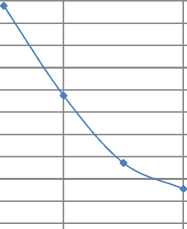
Таблица 4.
Прочностные характеристики пленок различной концентрации (усредненные)
Table 4.
Strength characteristics of films of various concentrations (averaged)
|
щ о и Ph fl s ° |
® Z я Й “ о а И J lx1 s |
Д8 >.щ |
5см cS § 8 5 s C S |
Щ m л ед 5 н § \O g ®"“°g 8 II Pi |
|
2,5% |
21,47 |
1,75 |
44,00 |
3,49 |
|
5% |
26,86 |
3,69 |
33,34 |
7,39 |
|
7,5% |
52,21 |
2,18 |
40,42 |
4,36 |
|
10% |
87,73 |
2,83 |
43,34 |
5,67 |
0,00% 5,00% 10,00%
Концентрация ПВС, %/PVA concentration, %
Рисунок 1. График изменения паропроницаемости
Figure 1. Schedule of changes in vapor permeability
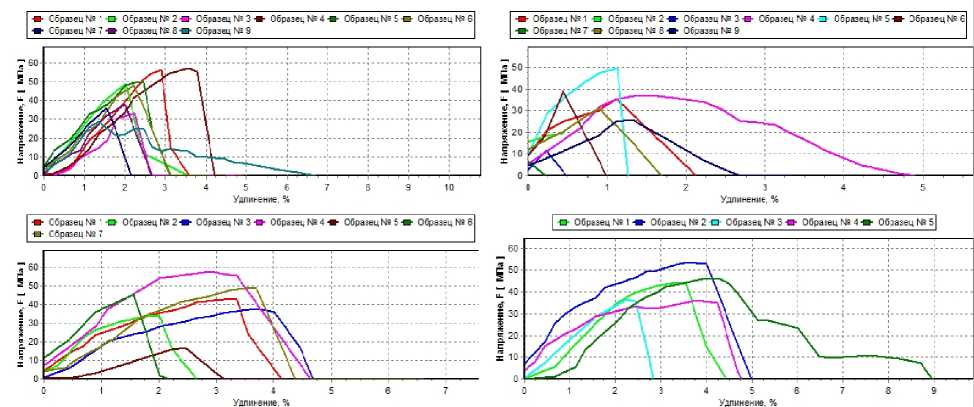
Рисунок 2. Графики измерения прочностных характеристик пленок различной концентрации
Figure 2. Graphs of measurement of strength characteristics of films of various concentrations
По результатам испытаний для дальнейшего проведения эксперимента и введение в образец пластификатора (глицерина) была выбрана пленка с концентрацией 10% ПВС имеющий наилучшие показатели как прочностные, так и барьерные.
На рисунках 6 и 7 представлены данные соответственно влияния концентрации пластификатора на физико-механические характеристики. Как видно из полученных зависимостей, введение небольшого количества пластификатора в ПВС до 30% приводит к обычно наблюдаемым в процессе пластификации совместимыми с полимером соединениями закономерностям – разрушающие напряжение уменьшается, относительное удлинение, и проницаемость полимера повышается по мере увеличения в полимере содержания пластификатора. Пластифицирующий эффект в данном случае определяется внутренней пластификацией полимера – проникновением молекул пластификатора между молекулами спирта, экранированием гидроксильных групп ПВС‚ что приводит к уменьшению молекулярного взаимодействия, а, следовательно, увеличению гибкости цепей и уменьшению сопротивления разрушению полимера.
В области концентраций пластификатор 30–45% наблюдается аномальный эффект пластификации. Сопротивление разрушению увеличивается, относительное удлинение заметно уменьшается, а проницаемость полимера резко повышается (больше, чем на порядок). Указанная закономерность сохранялась во всех случаях и может быть объяснена следующим образом: Поливиниловый спирт – жестко цепной кристаллический полимер.
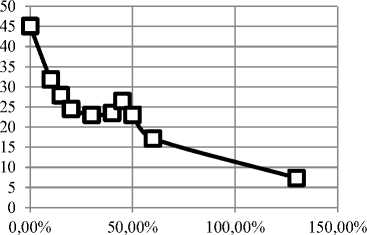
рц Концентрация пластификатора, в %
Concentration of plasticizer, in %
Рисунок 3. Зависимость разрушающего напряжения пленки из ПВС от количества, вводимого в нее пластификатора
Figure 3. Dependence of the destructive stress of the PVS film on the amount of plasticizer introduced into it
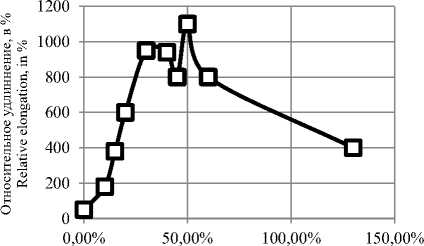
Концентрация пластификатора, в %
Concentration of plasticizer, in %
Рисунок 4. Зависимость относительного удлинения пленки из ПВС от количества, вводимого в нее пластификатора
Figure 4. Dependence of the relative elongation of the PVS film on the amount of plasticizer introduced into it
Введение глицерина в такой полимер повышает подвижность молекулярных цепей и облегчает их кристаллизацию. В зависимости от содержания и пластификатора происходит образование различных морфологических форм кристаллических структур, характер и размер, который оказывает большое влияние на свойства полимера.
При введении 30–45% пластификатора, предположительно происходит образование крупнокристаллических структур, образование которых
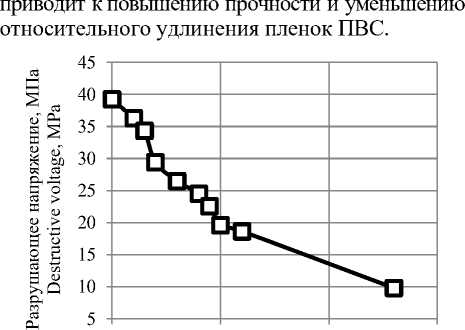
0,00% 50,00% 100,00% 150,00%
Концентрация пластификатора, в % Concentration of plasticizer, in %
Рисунок 5. Изменение разрушающего напряжения пленки из ПВС с различным содержанием пластификатора выдержанной в течение суток при 100% относительной влажности
Figure 5. Change in the destructive stress of the PVS film with different plasticizer content sustained during the day at 100% relative humidity
При дальнейшем увеличении концентрации пластификатора в ПВС > 50% происходит разбавление системы низкомолекулярным – компонентом, что ведет к уменьшению прочности и относительного удлинения.
Данные по изменению физико-механических испытаний пленок, выдержанных в течение суток при 100% влажности свидетельствуют рисунки 8 и 9. Как видно из представленных данных, кривые прочности пленок не имеют экстремума, лишь относительное удлинение пленок резко уменьшается в области концентраций пластификатора в полимере 30–45%.
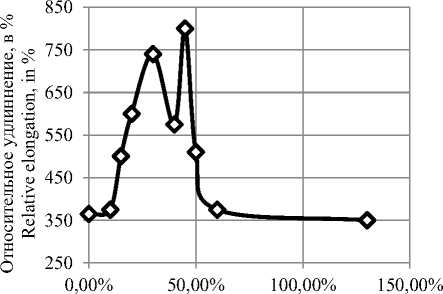
Концентрация пластификатора, в % Concentration of plasticizer, in %
Рисунок 6. Изменение относительного удлинения пленки из ПВС с различным содержанием пластификатора выдержанной в течение суток при 100% относительной влажности
Figure 6. Change in the relative elongation of the PVS film with different plasticizer content aged during the day at 100% relative humidity
Таким образом, изменением количества введенного в полимер пластификатора можно
Губанова М.И. и др. Вестник ВГУИТ, 2023, Т. 85, №. 2, С. 226-236 значительно менять свойства пленочных материалов. Введение 20–30% пластификатора приводит к получению достаточно эластичной пленки.
Заключение
Полученные зависимости характеристик ПВС от концентрации пластификатора являются результатами действий многих факторов на структуру и свойства полимера. Как известно, структура полимера формируется уже в растворе и зависит от введенных добавок. Введение пластификатора, который является растворителем ПВС, меняет состав растворителя: из водного он становится водно-пластифицированным.
По результатам проведенных исследований влияния пластификатора в широком диапазоне концентраций на свойства пленки на основе ПВС свидетельствует об экстремальном характере зависимости физико-механических характеристик полимера от содержания пластификатора, что связано с влиянием пластификатора
post@vestnik-vsuet.ru
на формирование структуры ПВС. Для получения эластичного пленочного материала на основе ПВС необходимо введение в полимер 30–40% пластификатора.
Влияние пластификатора на свойства структурированного ПВС выражено менее резко по сравнению с чистым полимером, что связано с многокомпонентностью системы и протеканием побочных реакций между пластификатором и структурирующим агентом. Выявлены различия в паропроницаемости у пленок с различной концентрацией ПВС.
Проведенный комплекс исследований позволил определить влияние модифицирующих добавок на структурные превращения ПВС композиций для создания покрытий нового поколения.
В будущем планируется продолжить исследования по данной тематике, в частности по оптимизации температурно-временного режима формирования покрытий.
Список литературы Исследование пленочных материалов, полученных из модифицированных растворных систем на основе поливинилового спирта
- Бабин А.Н., Гусева М.А. Использование реологического метода для исследования особенностей растворимости компонентов в полимерном связующем // Труды ВИАМ. 2016. 2016. №. 6 (42). С. 36-43. https://doi.org/10.18577/2307-6046-2016-0-6-5-5
- Кабат О.С., Харченко Б.Г., Деркач А.Д., Артемчук В.В. и др. Полимерные композиционные материалы на основе фторопласта и метод их получения // Вопросы Химии и Химической Технологии. 2019. №. 3. С. 116-122. https://doi.org/10.32434/0321-4095-2019-124-3-116-122.
- Каблов Е.Н. Из чего сделать будущее? Материалы нового поколения, технологии их создания и переработки-основа инноваций // Крылья родины. 2016. №. 5. С. 8-18.
- Каблов Е.Н. Материалы нового поколения-основа инноваций, технологического лидерства и национальной безопасности России // Интеллект и технологии. 2016. №. 2. С. 16-21.
- Andrade J., González-Martínez C., Chiralt A. Antimicrobial PLA-PVA multilayer films containing phenolic compounds // Food Chemistry. 2022. № 375. https://doi.org/10.1016/J.FOODCHEM.2021.131861
- Audic J., Chaufer B. Influence of plasticizers and crosslinking on the properties of biodegradable films made from sodium caseinate // Eur Polym J 2005. V. 41. № 8. P. 1934-42. https://doi.org/10.1016/j.eurpolymj.2005.02.023
- Averous L., Boquillon N. Biocomposites based on plasticized starch: thermal and mechanical behaviours // Carbohydrate polymers. 2004. V. 56. №. 2. P. 111-122. https://doi.org/10.1016/j.carbpol.2003.11.015
- Bergo P., Sobral PJA. Effects of plasticizer on physical properties of pigskin gelatin films // Food Hydrocolloids. 2007. V. 21. №. 8. P. 1285-1289. https://doi.org/10.1016/j.foodhyd.2006.09.014
- Bergo P.V.A., Carvalho R.A., Sobral P.J.A., dos Santos R.M.C. et al. Physical properties of edible films based on cassava starch as affected by the plasticizer concentration // Packaging Technology and Science. 2008. V. 21. №. 2. P. 85-89. https://doi.org/10.1002/pts.781
- Bertan L.C., Tanada-Palmu P.S., Siani A.C., Grosso C.R.F. Effect of fatty acids and “Brazilian elemi” on composite films based on gelatin // Food Hydrocolloids. 2005. V.19. №. 1. P. 73-82. https://doi.org/10.1016/j.foodhyd.2004.04.017
- Bordes P., Pollet E., Avérous L. Nano-biocomposites: biodegradable polyester/nanoclay systems // Progress in Polymer Science. 2009. V 34. №. 2. P. 125-155. https://doi.org/10.1016/j.progpolymsci.2008.10.002
- Fan K., Zhang M., Jiang F. Ultrasound treatment to modified atmospheric packaged fresh-cut cucumber: Influence on microbial inhibition and storage quality // Ultrasonics Sonochemistry. 2019. № 54. P. 162-170. https://doi.org/10.1016/j.ultsonch.2019.02.003
- Garcia M.A., Martino M.N., Zaritzky N.E. Lipid Addition to Improve Barrier Properties of Edible Starch-based Films and Coatings // Journal of Food Science. 2000. V. 65. №. 6. P. 941-944. https://doi.org/10.1111/j. 1365-2621.2000.tb09397.x
- Hemmatgir F., Koupaei N., Poorazizi E. Characterization of a novel semi-interpenetrating hydrogel network fabricated by polyethylene glycol diacrylate/polyvinyl alcohol/tragacanth gum as a wound dressing // Burns. 2022. V. 48. №. 1. P. 146-155. https://doi.org/10.1016/J.BURNS.2021.04.025
- Hu H., Yong H., Yao X., Chen D. et al. Effect of starch aldehyde-catechin conjugates on the structural, physical and antioxidant properties of quaternary ammonium chitosan/polyvinyl alcohol films // Food Hydrocolloids. 2022. V. 124. https://doi.org/10.1016/J.FOODHYD.2021.107279
- Jongjareonrak A., Benjakul S., Visessanguan W., Tanaka, M. Effects of plasticizers on the properties of edible films from skin gelatin of bigeye snapper and brownstripe red snapper // European Food Research and Technology. 2005. V. 222. №. 3-4. P. 229-235. https://doi.org/10.1007/s00217-005-0004-3
- Kan J., Liu J., Xu F., Yun D. et al. Development of pork and shrimp freshness monitoring labels based on starch/polyvinyl alcohol matrices and anthocyanins from 14 plants: A comparative study // Food Hydrocolloids. 2022. V. 124. doi. 10.1016/J.FOODHYD.2021.107293
- Kariminejad M., Zibaei R., Kolahdouz-Nasiri A., Mohammadi R. et al. Chitosan/polyvinyl alcohol/SiO2 nanocomposite films: Physicochemical and structural characterization // Biointerface Research in Applied Chemistry. 2022. V. 12. №. 3. P. 3725-3734. https://doi.org/10.33263/BRIAC123.37253734
- Karnnet S., Potiyaraj P., Pimpan V. Preparation and properties of biodegradable stearic acid-modified gelatin films // Polym Degrad Stab. 2005. V. 90. №. 1. P. 106-10. https://doi.org/10.1016/j.polymdegradstab.2005.02.016
- Ling H., Shen Y., Xu L., Pan H. et al. Preparation and characterization of dual-network interpenetrating structure hydrogels with shape memory and self-healing properties // Colloids and Surfaces A: Physicochemical and Engineering Aspects. 2022. P. 636. https://doi.org/10.1016/J.COLSURFA.2021.128061
- Lu S., Tao J., Liu X., Wen Z. Baicalin-liposomes loaded polyvinyl alcohol-chitosan electrospinning nanofibrous films: Characterization, antibacterial properties and preservation effects on mushrooms // Food Chemistry. 2022. V. 371. https://doi.org/10.1016/J.FOODCHEM.2021.131372
- MA X. The plastcizers containing amide groups for thermoplastic starch // Carbohydrate Polymers. 2004. V. 57. №. 2. P. 197-203. https://doi.org/10.1016/j.carbpol.2004.04.012
- Pashova S., Radev R., Dimitrov G. Physical properties of edible films with different composition // Calitatea. 2019. V. 20. №. 171. P. 152-156.
- Rhim J.-W., Park H.-M., Ha C.-S. Bio-nanocomposites for food packaging applications // Progress in Polymer Science. 2013. V. 38. №. 10-11. P. 1629-1652. https://doi.org/10.1016/j.progpolymsci.2013.05.008
- Sau S., Kundu S. Variation in structure and properties of poly(vinyl alcohol) (PVA) film in the presence of silver nanoparticles grown under heat treatment // Journal of Molecular Structure. 2022. V. 1250. https://doi.org/10.1016/J.MOLSTRUC.2021.131699.
- Shaikh H.M., Pandare K.V., Nair G., Varma A.J. Utilization of sugarcane bagasse cellulose for producing cellulose acetates: Novel use of residual hemicellulose as plasticizer // Carbohydrate Polymers. 2009. V. 76. №. 1. P. 23-29. https://doi.org/10.1016/j.carbpol.2008.09.014
- Singha P., Rani R., Badwaik L.S. Sweet lime peel-, polyvinyl alcohol - and starch-based biodegradable film: preparation and characterization // Polymer Bulletin. 2022. https://doi.org/10.1007/S00289-021-04040X
- Sobral PJA., Santos JS., García FT., Effect of protein and plasticizer concentrations in film forming solutions on physical properties of edible films based on muscle proteins of a Thai Tilapia // J Food Eng. 2005. V. 70. № 1. P. 93-100. https://doi.org/10.1016/j.jfoodeng.2004.09.015
- Suhag A., Biswas K., Singh S., Kulshreshtha A. Crosslinking effect on polyvinyl alcohol resin for barrier properties of barrier biaxial orientation films // Progress in Organic Coatings. 2022. V. 163. https://doi.org/10.1016/J.PORGCOAT.2021.106662
- Suyatma N.E., Tighzert L., Copinet A., Coma V. Effects of hydrophilic plasticizers on mechanical, thermal, and surface properties of chitosan films // Journal of Agricultural and Food Chemistry. 2005. V. 53. № 10. P. 3950-3957. https://doi.org/10.1021/jf048790
- Tharanathan R.N. Biodegradable films and composite coatings: past, present and future. Trends in food science & technology. 2003. V. 14. № 3. P. 71-78. https://doi.org/10.1016/S0924-2244(02)00280-7
- Thulasisingh A., Kumar K., Yamunadevi B., Poojitha N. et al. Biodegradable packaging materials // Polymer Bulletin. 2021. P. 15-23. https://doi.org/10.1007/s00289-021-03767x
- Vieira M.G.A., da Silva M.A., dos Santos L.O., Beppu M.M. Natural-based plasticizers and biopolymer films: A review // European Polymer Journal. 2011. V. 47. № 3. P. 254-263. https://doi.org/10.1016/j.eurpolymj.2010.12.011
- Wang Q., Chen W., Zhu W., McClements D.J. et al. A review of multilayer and composite films and coatings for active biodegradable packaging // Npj Science of Food. 2022. V. 6. № 1. https://doi.org/10.1038/s41538-022-00132-8
- Wang Y., Zhang J., Zhang L. An active and pH-responsive film developed by sodium carboxymethyl cellulose/polyvinyl alcohol doped with rose anthocyanin extracts // Food Chemistry. 2022. V. 373. https://doi.org/10.1016/J.FOODCHEM.2021.131367
- Wittaya T. Protein-Based Edible Films: Characteristics and Improvement of Properties // Structure and Function of Food Engineering. 2012. https://doi.org/10.5772/48167
- Xie J., Wang R., Li Y., Ni Z. et al. A novel Ag2O-TiO2Bi2WO6/polyvinyl alcohol composite film with ethylene photocatalytic degradation performance towards banana preservation // Food Chemistry. 2022. V. 375. https://doi.org/10.1016/J.FOODCHEM.2021.131708
- Xie Y., Pan Y., Cai P. Hydroxyl crosslinking reinforced bagasse cellulose/polyvinyl alcohol composite films as biodegradable packaging // Industrial Crops and Products. 2022. V. 176. https://doi.org/10.1016/J.INDCROP.2021.114381
- Zhang X., Zou W., Xia M., Zeng Q. et al. Intelligent colorimetric film incorporated with anthocyanins-loaded ovalbumin-propylene glycol alginate nanocomplexes as a stable pH indicator of monitoring pork freshness // Food Chemistry, 2022. V. 368. https://doi.org/10.1016/J.FOODCHEM.2021.130825
- Zhang Y., Gao Q., Zhang S., Fan X. et al. rGO/MXene sandwich-structured film at spunlace non-woven fabric substrate: Application to EMI shielding and electrical heating // Journal of Colloid and Interface Science. 2022. V. 614. P. 194-204. https://doi.org/10.1016/J.JCIS.2022.01.030
- Zhao R., Guan W., Zheng P., Tian F. et al. Development of edible composite film based on chitosan nanoparticles and their application in packaging of fresh red sea bream fillets // Food Control. 2022. V. 132. https://doi.org/10.1016/J.FOODCONT.2021.108545
- Zheng L., Liu L., Yu J., Shao P. Novel trends and applications of natural pH-responsive indicator film in food packaging for improved quality monitoring // Food Control. 2022. V. 134. https://doi.org/10.1016/J.FOODCONT.2021.108769

